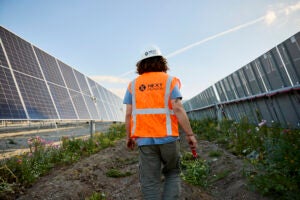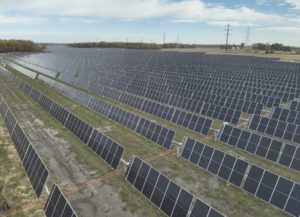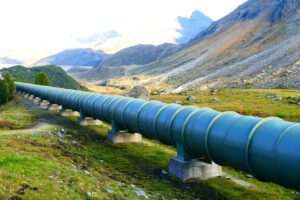The global wind industry is entering a new phase of accelerated growth as both companies and countries adopt ambitious sustainable energy goals. 2023 was a record year for wind installations, with a 50% increase in new wind power generated, according to the Global Wind Energy Council. While the value of wind as a renewable energy source is becoming better understood, there is much to be done to meet ambitious goals and Ireland is becoming a hotspot for innovation and development in the space.
With a total maritime area more than seven times the size of its landmass, Ireland has one of the largest marine areas in the European Union (EU) to support offshore wind installations. Now, with 300 wind farms generating close to 4.8 GW of clean energy, Ireland is third in the world for installed wind power capacity per capita. In December 2023 alone, 55% of all electricity generated in Ireland came from wind. The country’s aggressive sustainability goals and incentives make it an attractive destination for further wind advancements in 2024 and beyond, and several trends are driving Ireland’s wind ecosystem.
 |
|
Ireland’s offshore wind industry is being supported by government initiatives, including a $100 billion investment plan. Courtesy: Jesse De Meulenaere / IDA Ireland |
Renewables are a top government priority. The Irish Government in March 2024 published “Powering Prosperity: Ireland’s Offshore Wind Industrial Strategy,” detailing how industry stakeholders will collaborate to support the growth and development of the sector to reach 37 GW of offshore wind by 2050. The $100 billion investment plan is structured around four core pillars: The supply chain, the RD&I (Research, Development, and Innovation) ecosystem, regional development, and forward-looking development and end-use. In total, it includes 40 actions that will be implemented in 2024 and 2025 to support a resilient offshore wind industry and ensure Irish companies play a major role. The country is also implementing a suite of policies that will support the program, including national and EU funding directed toward decarbonization projects.
Ireland’s 2024 budget includes incentives for investment in renewable energy technology. Tax credits for research and development (R&D) initiatives have been increased from 25% to 30% to support programs that contribute to decarbonization. However, the incentives aren’t exclusive to renewable energy companies. Accelerated capital allowances for energy-efficient equipment were extended through December 2025 to support a wave of investment from all industries, allowing businesses to tap into technology that supports decarbonization goals. Many large sectors in Ireland, like life sciences and medical technology, have highly ambitious sustainability goals and Ireland is supporting those companies with capital grants to incentivize the adoption of green tech.
As Ireland executes its offshore wind strategy, it will continue to announce programs and incentives for entrepreneurial companies supporting the development and deployment of renewable energy. The country is committed to creating a vibrant ecosystem that supports all decarbonization goals.
Infrastructure is advancing. Growing Ireland’s offshore wind capacity will require significant infrastructure advancements and investment, which are currently underway. In 2023, Irish and UK officials announced a memorandum of understanding (MoU) to increase renewable energy development and electricity interconnection. The MoU will increase opportunities for electrical interconnection between the countries to support decarbonization priorities. Electricity interconnectors enable electricity trading between countries, and their development will play a major role in the future of the EU’s energy.
Overall, Ireland’s interconnection capacity is set to more than triple by 2027 with the addition of five electricity interconnectors to support the export of wind power. Plans have been proposed for links between Ireland and Great Britain, France, Spain, Belgium, the Netherlands, and Scotland. The newest interconnector, the Celtic Interconnector, which will run between Cork and France, is due to be operational in 2027. As part of the “Powering Prosperity” offshore wind strategy, Ireland also is designating specific offshore sites for development while scaling up marine planning, supply chains, and grid connection. Ireland was the first in the world to have an electrical grid capable of up to 75% variable renewable resource integration, and work is currently underway to increase that figure to 95% by 2030.
As investment in offshore wind infrastructure continues, Ireland’s existing offshore capacity is making headway. Ireland made history by conducting the country’s first offshore wind auction in May 2023, which attracted major interest from global wind energy developers. Overall, the auction awarded contracts to four offshore wind projects with a combined capacity of 3 GW. The first of these projects could be operational as soon as 2028 or 2029.
Future auctions are being planned to align with onshore grid capacity. The next is scheduled to take place off Ireland’s south coast and will procure up to 900 MW of offshore wind. Port expansions are also being planned to support wind development. The first ports to be expanded are in Cork and Rosslare, where significant offshore fixed-turbine development is expected. Infrastructure investments like these will be critical for Ireland’s wind ecosystem, and it is already attracting industry-leading renewable developers to the country.
There are several major players supporting a “green economy” in Ireland, a country with one of the most ambitious decarbonization plans in the world. This makes it an attractive location for leading global companies and startups to expand or invest in for the first time. Many major renewable energy developers have a growing presence in Ireland, such as the first auction winners, which include Fred. Olsen Seawind; EDF Renewables; RWE; Copenhagen Infrastructure Partners; Statkraft; Corio Generation, a portfolio company of Macquarie’s Green Investment Group; and global infrastructure investor Ontario Teachers’ Pension Plan.
Aside from development opportunities with Ireland’s massive offshore marine area, renewable energy companies are also choosing the country for other reasons. Ireland has one of the highest levels of STEM (science, technology, engineering, math) graduates per capita in the EU among 20- to 29-year-olds, providing a rich pool of talent to support R&D initiatives. The depth of engineering talent has attracted some of the biggest names in manufacturing and the renewables industry is following suit. For example, U.S. company SkySpecs uses drone technology and data analytics to inspect and check the performance of wind turbines in Ireland. Powerverse, owned by Lightsource BP, is a smart energy management company whose Limerick operation specializes in embedded software and cloud infrastructure. Venterra Group, through its subsidiary Gavin & Doherty Geosolutions, provides engineering services for offshore wind developers with a team of close to 150 people in Dublin and Cork. This growing ecosystem of companies will only further accelerate Ireland’s wind capacity as investment continues.
Sustainable energy is one of the most pressing concerns across the globe and Ireland is home to a hive of activity in the space. Due to government support and incentives, the green economy supply chain is heating up in Ireland, and it’s only just begun. As more wind parks are approved and infrastructure continues to advance, Ireland will solidify itself as a leading destination for sustainable technology.
—Joseph Collum is sustainability manager for IDA Ireland.










